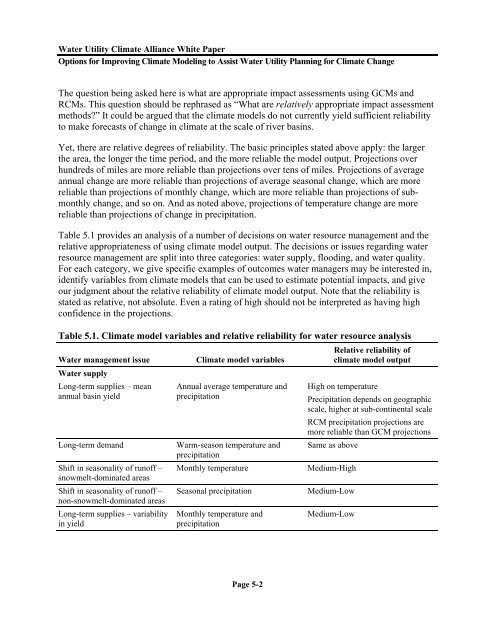Options for Improving Climate Modeling to Assist Water Utility ...
Options for Improving Climate Modeling to Assist Water Utility ...
Options for Improving Climate Modeling to Assist Water Utility ...
Create successful ePaper yourself
Turn your PDF publications into a flip-book with our unique Google optimized e-Paper software.
<strong>Water</strong> <strong>Utility</strong> <strong>Climate</strong> Alliance White Paper<br />
<strong>Options</strong> <strong>for</strong> <strong>Improving</strong> <strong>Climate</strong> <strong>Modeling</strong> <strong>to</strong> <strong>Assist</strong> <strong>Water</strong> <strong>Utility</strong> Planning <strong>for</strong> <strong>Climate</strong> Change<br />
The question being asked here is what are appropriate impact assessments using GCMs and<br />
RCMs. This question should be rephrased as “What are relatively appropriate impact assessment<br />
methods?” It could be argued that the climate models do not currently yield sufficient reliability<br />
<strong>to</strong> make <strong>for</strong>ecasts of change in climate at the scale of river basins.<br />
Yet, there are relative degrees of reliability. The basic principles stated above apply: the larger<br />
the area, the longer the time period, and the more reliable the model output. Projections over<br />
hundreds of miles are more reliable than projections over tens of miles. Projections of average<br />
annual change are more reliable than projections of average seasonal change, which are more<br />
reliable than projections of monthly change, which are more reliable than projections of submonthly<br />
change, and so on. And as noted above, projections of temperature change are more<br />
reliable than projections of change in precipitation.<br />
Table 5.1 provides an analysis of a number of decisions on water resource management and the<br />
relative appropriateness of using climate model output. The decisions or issues regarding water<br />
resource management are split in<strong>to</strong> three categories: water supply, flooding, and water quality.<br />
For each category, we give specific examples of outcomes water managers may be interested in,<br />
identify variables from climate models that can be used <strong>to</strong> estimate potential impacts, and give<br />
our judgment about the relative reliability of climate model output. Note that the reliability is<br />
stated as relative, not absolute. Even a rating of high should not be interpreted as having high<br />
confidence in the projections.<br />
Table 5.1. <strong>Climate</strong> model variables and relative reliability <strong>for</strong> water resource analysis<br />
Relative reliability of<br />
<strong>Water</strong> management issue<br />
<strong>Climate</strong> model variables<br />
climate model output<br />
<strong>Water</strong> supply<br />
Long-term supplies – mean<br />
annual basin yield<br />
Annual average temperature and<br />
precipitation<br />
High on temperature<br />
Precipitation depends on geographic<br />
scale, higher at sub-continental scale<br />
RCM precipitation projections are<br />
more reliable than GCM projections<br />
Long-term demand<br />
Warm-season temperature and Same as above<br />
precipitation<br />
Shift in seasonality of runoff – Monthly temperature<br />
Medium-High<br />
snowmelt-dominated areas<br />
Shift in seasonality of runoff –<br />
non-snowmelt-dominated areas<br />
Seasonal precipitation<br />
Medium-Low<br />
Long-term supplies – variability<br />
in yield<br />
Monthly temperature and<br />
precipitation<br />
Medium-Low<br />
Page 5-2

















